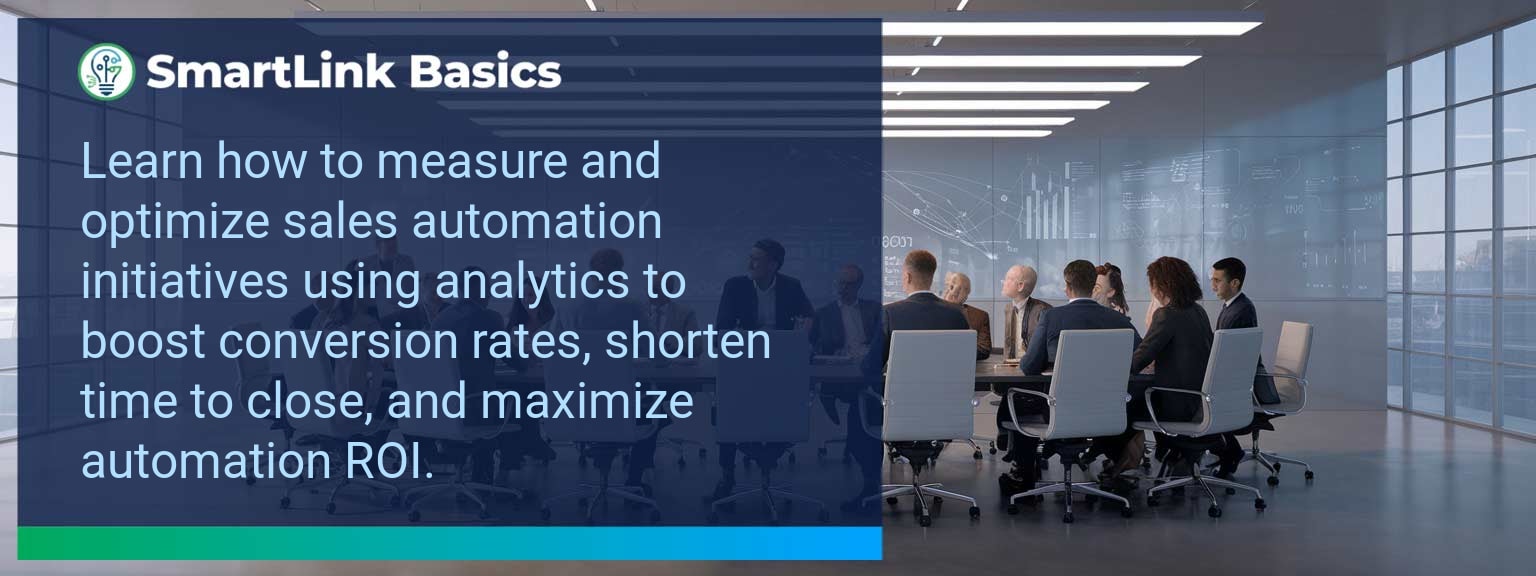Industry data shows that organizations adopting AI-driven automation achieve cost reductions of up to 30% while accelerating sales cycles by 20% or more (McKinsey, 2024). For sales leaders, AI automated workflows now define competitive advantage, enabling teams to reallocate time from repetitive tasks to high-value engagements. At SmartLink Basics, we help decision-makers implement these systems strategically, ensuring they integrate with existing revenue operations. In this article, you’ll see how AI automated workflows power business outcomes, the common obstacles that slow adoption, and practical steps to optimize processes. You’ll walk away with proven examples, a 90-day action blueprint, and measurable KPIs to track results.
- Automate repetitive administrative and CRM updates with AI.
- Integrate machine learning to personalize outreach at scale.
- Streamline approvals, quotes, and contract workflows for speed.
- Use predictive analytics to prioritize sales opportunities.
- Track adoption and performance with targeted metrics.
AI Automated Workflows: What Changed and Why It Matters
AI adoption has shifted from experimental to operational, making automated workflows a standard in high-performing sales organizations. The real advantage lies in combining workflow automation with artificial intelligence workflows to optimize every step of the revenue process. Sales leaders now use AI to synchronize touchpoints, reduce manual inputs, and ensure faster execution. For example, a B2B SaaS leader introduced automated lead enrichment and routing, cutting qualification time by 60%. Actionable insight: Audit processes for time-intensive handoffs and apply AI where repeatability is high.Redesign the Revenue Operating System With AI Automated Workflows
ICP, Segmentation, and Targeting AI-enabled segmentation uses historical wins, firmographic, and behavioral data to dynamically update ICP profiles. This ensures targeting precision without quarterly re-work. Pipeline Architecture Automated workflows push opportunities through the right stages based on engagement signals. AI flags at-risk deals for intervention. Plays and Messaging Integrated automation tools deliver personalized sequences based on buyer activity, increasing relevance at every touchpoint. Operating Cadence AI schedules follow-ups, forecast calls, and account reviews based on actual pipeline movement rather than static calendars. Actionable insight: Implement automation that adapts in real-time to both internal and buyer-driven events.Common Obstacles To Achieving Seamless Automation
The most frequent challenges are fragmented systems, inconsistent data quality, and cultural resistance. Without a unified data layer, automation amplifies errors rather than solving them. Coca-Cola Europacific Partners reported needing a full data governance upgrade before AI could improve sales workflows. Leaders must first assess infrastructure readiness and train teams to trust AI-influenced recommendations. Actionable insight: Before deployment, establish clean data practices and a single source of truth.Implementing AI To Optimize Workflows
Effective deployment of AI process optimization starts with mapping current-state processes, identifying friction points, and matching them with automation tools. For example, automating proposal generation based on CRM opportunity data can reduce turnaround from three days to one hour. Solutions combining business process automation platforms with machine learning integration enable continuous performance improvement. Actionable insight: Pilot in one high-impact stage, measure, and then expand.Tangible Benefits From Automated Processes
The benefits extend beyond time savings — sales leaders gain a scalable system. Tangible outcomes include faster quote-to-close, higher lead conversion, and better forecast accuracy. A manufacturing firm implemented AI-assisted order processing and cut errors by 40%, improving on-time delivery rates. Actionable insight: Track both speed and accuracy to measure workflow automation effectiveness.Metrics That Matter
| Category | Metric | Definition | Target |
|---|---|---|---|
| Leading | Workflow Completion Rate | % of automated sequences executed without manual intervention | 95%+ |
| Leading | AI Suggestion Adoption Rate | % of AI-generated action recommendations executed by reps | 80%+ |
| Lagging | Cycle Time Reduction | Decrease in time from lead entry to closed-won | 20%+ |
| Lagging | Revenue Per Rep | Average sales revenue generated per sales rep per quarter | +15% YoY |
| Quality | Automation Error Rate | % of workflows that trigger incorrect outcomes | <1% |
| Quality | Customer Satisfaction Post-Automation | Average CSAT score after automation implementation | ≥ 4.5/5 |
Innovations And Next Steps For AI Automation
Emerging capabilities like AI-generated playbooks, intent-driven dynamic routing, and integrated AR for virtual product demos are shaping the next wave of sales automation. Companies integrating these tools early will outpace competitors in speed and personalization. Actionable insight: Stay ahead by testing emerging automation features quarterly and aligning them with evolving buyer expectations.Get the 90-day plan, coaching rubric, and dashboard template to operationalize AI in your enablement program.
Turning AI Automation Into a Revenue Multiplier
AI automated workflows are now a strategic lever for predictable, scalable growth. This guide outlined current applications, adoption challenges, a 90-day execution plan, and measurable success criteria. To make automation pay off, sales leaders should integrate tools into one cohesive operating system and review results monthly for continuous improvement. Access more AI-driven sales enablement resources from SmartLink Basics to design a high-performance automation strategy. Strong sales leadership strategies determine whether a team consistently hits revenue targets or struggles to keep momentum. According to SmartLink Basics, leaders who master constructive feedback, streamline processes, and build a culture of accountability can drive sales performance improvement that compounds over time. With shifting buyer expectations and compressed deal cycles, leadership in sales now demands precision in coaching sales teams, motivating salespeople, and implementing effective feedback frameworks. This article outlines practical, battle-tested methods for sales team management that increase win rates, shorten sales cycles, and create measurable gains that decision-makers can track.- Define clear performance expectations linked to revenue outcomes
- Deliver constructive feedback regularly using a structured approach
- Align sales plays with ideal customer profiles and segments
- Establish a consistent operating cadence for reviews and pipeline health
- Track leading and lagging metrics for accurate performance management
What Changed And Why It Matters Now In Sales Leadership Strategies
Sales cycles are increasingly influenced by digital buyer behavior and rapid market shifts. Leaders can no longer rely on sporadic coaching or end-of-quarter corrections. High-performance sales leadership strategies prioritize proactive management, where leaders engage in pipeline reviews, deal coaching, and strategic account planning weekly. By refining sales team management processes, leaders address small performance deviations before they impact revenue. For example, a regional VP who integrated a structured weekly feedback loop saw time-to-close improve by 18% within a single quarter.Redesign the Revenue Operating System With Sales Leadership Strategies
Redesigning your revenue system involves aligning every sales motion with customer value and operational efficiency. Successful leaders focus on four structural levers. ICP, Segmentation, and Targeting Clarifying your ideal customer profile allows the team to prioritize accounts with the highest probability of conversion. For instance, a software firm that narrowed its focus from eleven verticals to four saw lead-to-close rates rise by 23% in six months. Pipeline Architecture Your pipeline must illustrate not only deal stages but also key conversion triggers. Strong sales performance improvement comes from highlighting and addressing conversion bottlenecks early. Plays and Messaging Standardized plays keep messaging consistent and effective. This builds buyer trust and eliminates revenue leakage caused by inconsistent positioning. Operating Cadence Set weekly forecast reviews, monthly pipeline deep-dives, and quarterly territory planning. This consistency reinforces accountability and accelerates closing deals faster.Common Obstacles In Leading A Sales Team
Many leaders face challenges such as unclear performance metrics, inconsistent coaching practices, and low engagement during change initiatives. Misaligned incentives between departments can also slow revenue momentum. For example, a company rewarding individual quota achievement without team collaboration saw high churn among top performers due to competition over strategic accounts. Overcoming these issues requires precise leadership in sales, anchored in transparent objectives and unified sales team management.Strategies To Strengthen Sales Leadership
Effective sales leadership hinges on measurable coaching systems, not ad-hoc interventions. Leaders should deploy scorecards tracking both activity (calls, meetings) and outcomes (closed deals, growth in share of wallet). Feedback should be fact-based and outcome-oriented, focusing on what can be improved in the next buyer interaction. A mid-market SaaS firm that implemented bi-weekly skill-based coaching saw its average deal size increase by 12% within two quarters.Measurable Gains From Improved Sales Leadership
Tangible performance improvements include increased quota attainment, higher forecast accuracy, and shorter sales cycles. The following table outlines key metrics across categories:| Category | Metric | Definition | Target |
|---|---|---|---|
| Leading | Pipeline Coverage Ratio | Total pipeline value divided by quota | 3:1 |
| Lagging | Win Rate | Percentage of deals closed from total pipeline | >30% |
| Quality | Average Deal Cycle Time | Days from initial contact to close | <60 days |
Evolving Leadership Approaches For Sustained Success
Sustaining revenue growth means adapting leadership methods to market changes. This may involve integrating digital sales tools, leveraging predictive analytics, or restructuring incentive plans. The most effective leaders treat their sales operating model as a living framework, refining it based on performance data and customer feedback. Consistent alignment of strategy, coaching, and metrics ensures teams remain agile and able to close deals faster regardless of economic cycles.Get the 90-day plan, coaching rubric, and dashboard template to operationalize AI in your enablement program.
Effective sales leadership depends on structure, clarity, and a relentless focus on measurable progress. Apply these strategies, monitor key metrics, and refine continuously to ensure your team consistently outperforms.









